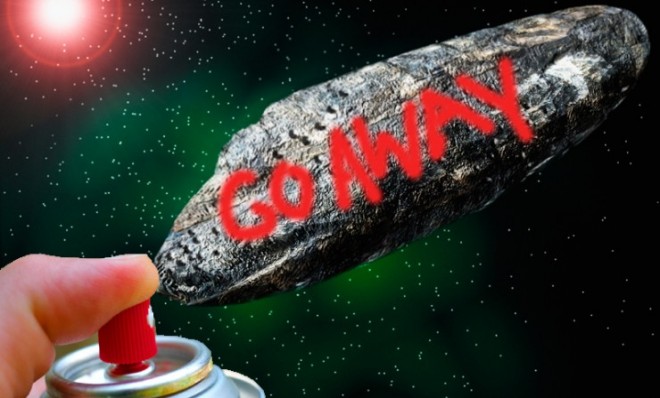6 clever ways to avoid getting hit by an asteroid
Why nuke a space rock when you can cover it with spray paint or zap it with lasers?

Asteroids zip by Earth all the time. Nearly all of them pose absolutely no threat, but thanks to the magic of Hollywood, our culture is pervaded by a culpable fear that just one wayward space rock will lead to humankind's end. But don't worry: The chances of an asteroid slamming into our planet are incredibly small. For example, Apophis, the doom-bringing 900-foot-wide asteroid that swung by Earth in January, has a 99.9993 percent chance of missing us on its next pass in 2029. Plus, NASA and other space agencies around the globe have the trajectories of most near-Earth asteroids scouted out years in advance. And even if one is heading our way, scientists have devised several clever ways to deal with a space rock hurtling toward us. Here, six ingenious ways to stop an asteroid:
1. Hit it with spray paint
According to Wired, this method taps into a phenomenon called the Yarkovsky effect, which causes the asteroid to heat up as the sun's light hits it. (It's kind of like wearing a black shirt on a summer day.) As the paint-covered side of an asteroid heats up, the amount of light it reflects changes, causing the hot side to face toward space, where it would start emitting photons. The thinking goes that these photons would act as tiny rocket boosters to gently nudge the asteroid off course from its potentially disastrous meeting with our delicate little planet. NASA scientists are considering a test-run of this technique the next time Apophis swings by.
The Week
Escape your echo chamber. Get the facts behind the news, plus analysis from multiple perspectives.

Sign up for The Week's Free Newsletters
From our morning news briefing to a weekly Good News Newsletter, get the best of The Week delivered directly to your inbox.
From our morning news briefing to a weekly Good News Newsletter, get the best of The Week delivered directly to your inbox.
2. Use mirrors to move it
Scientists found that by using 10 small spacecraft equipped with 20-meter-wide inflatable mirrors, they could heat a small asteroid's surface to more than 2,100 degrees C, or enough to create thrust in the opposite direction. The only problem: It would take a lot of spacecraft to deal with an unusually large space rock: A 20-kilometer asteroid, like the kind that wiped out the dinosaurs, would require the combined effort of 5,000 mirror-equipped spacecraft intensely refocusing the sun's light for three years — at least.
3. Shade it with a solar sail
Instead of heating the asteroid up, you could cool it down with some shade. French researchers say that using a massive solar sail to block the sun's radiation would eliminate the Yarkovsky effect entirely, and thus take a small amount of thrust away from the warm side. According to Popular Science, this should, in theory, throw the asteroid out of orbit slightly enough to make it miss Earth.
A free daily email with the biggest news stories of the day – and the best features from TheWeek.com
4. Swarm it with robots
It may sound like science fiction, but NASA has actually looked into unleashing a hoard of ravenous, piranha-like robots on a civilization-annihilating asteroid. These Modular Asteroid Deflection Mission Ejector Node robots, or MADMEN for short, would swarm an unsuspecting asteroid, attach themselves to one side, and begin drilling into the surface, effectively serving as tiny little pushes. Get enough of these going, and — voilà! — humanity's in the clear.
5. Slam it with a space probe
No, we probably wouldn't nuke an asteroid, especially since that would just cause smaller, newly radioactive rock fragments to spiral down at Earth. That's why our best bet to handle a near-Earth Asteroid may be to leave it in one piece, and knock it off course with space probes. First, a speedy probe would ram into a killer asteroid at full speed, which should change its trajectory. Then we'd send a second probe to establish a "station-keeping position" near the space rock, "using its own gravity to very gently tug the rock into a safe orbit."
6. Zap it with lasers
This is roughly the same idea as using spacecraft equipped with mirrors. But instead of several tiny spacecraft merely reflecting the sun's rays at the asteroid, you're using solar energy to generate high-powered laser beams. Pew pew!
-
 Heavenly spectacle in the wilds of Canada
Heavenly spectacle in the wilds of CanadaThe Week Recommends ‘Mind-bending’ outpost for spotting animals – and the northern lights
-
 Facial recognition: a revolution in policing
Facial recognition: a revolution in policingTalking Point All 43 police forces in England and Wales are set to be granted access, with those against calling for increasing safeguards on the technology
-
 Codeword: December 14, 2025
Codeword: December 14, 2025The daily codeword puzzle from The Week